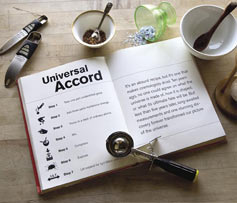

Monday - April 16, 2007
SLAC Today is
available online at:
http://today.slac.stanford.edu
In this issue:
symmetry: Universal Accord
Dorfan Today: SAFE '07
Passwords Must Now Change Every 6 Months
New Procedures for Prescription Safety Glass Purchases
Safety Firsts
 |
 |
|
Monday - April 16, 2007 |

Image courtesy of Fermilab's Fred Ullrich.
symmetry: Universal AccordTake one part unidentified goop. Add three parts mysterious energy. Throw in a dash of ordinary atoms. Mix. Compress. Explode. Let expand for 13.7 billion years. It's an absurd recipe, but it's one that makes cosmologists drool. Ten years ago, no one could agree on what the universe is made of, how it is shaped, or what its ultimate fate will be. But less than five years later, long-awaited measurements and one stunning discovery forever transformed our picture of the universe. The resulting model, often called the concordance model, holds that 22 percent of the universe is composed of dark matter, which pulls the universe together through gravity, and 74 percent dark energy, which pushes the universe apart. It is a cosmic recipe that unifies all astronomical observations to date, and though researchers do not yet understand what the ingredients are really made of, they know it tastes right.
"The concordance model is a real aesthetic achievement," says Steven Kahn, an astronomer at the Kavli Institute for Particle Astrophysics and Cosmology at SLAC and Stanford University. "We have a really successful theory. It's just amazing how well it works. That story hasn't been told." Part of the problem, he says, is that scientists don't dwell on their successes. They're always looking at the next big mystery. |
||
|
|
||
 SAFE '07One of the fundamentals in preventing accidents is to increase awareness through communication and education. This week we are launching the SAFE '07 program to focus on the many individuals and groups at SLAC that have outstanding safety records. Tomorrow, posters featuring Plating Shop Manager Ali Farvid and his team will appear around the laboratory and the practices of Ali's shop—which hasn't had an accident in the past two decades—will be featured in a SLAC Today article. Each month, another example of work done safely and efficiently by a group at SLAC will be featured on a poster. Each new poster will replace that of the previous month on billboards around the laboratory, and will also join its predecessors in a permanent display in the Panofsky Auditorium breezeway. Ali Farvid said something that particularly struck me. Talking about the excellent safety record in the plating shop he said, "We take care of one another." As with nearly every task and project, safety awareness becomes easier and more effective when handled as a team. If I look out for my colleagues and they look out for me, it more than doubles my effectiveness. When I am watching out for the colleagues with whom I work, I pay closer attention to potential hazards they might be exposed to and I will likely see hazards that I might have missed before. Each individual's first responsibility in safety awareness is to make sure they look after themselves, but I agree with Ali. We can raise safety to a yet higher level of excellence by also taking responsibility for the well-being of those around us. The SAFE '07 campaign focuses on specific safety achievements and will highlight success stories here at SLAC. Safety is of critical importance to our jobs, and I look forward to learning more about the countless individuals and groups who are raising our standards to make the lab an ever safer workplace. Have a SAFE '07! |
Passwords Must Now Change Every 6 Months
Passwords are how we protect computing systems at SLAC. Our policies for the administration and use of passwords are subject to Department of Energy (DOE) oversight; and, as a result, beginning on Tuesday, April 17, we will implement a new policy for password expiration to complete one of the Plan Of Action and Milestones which was created during a recent Site Assistance Visit from the DOE. As of tomorrow morning, all passwords for all SLAC information systems will need to be changed every six months. Read more... New Procedures for the Purchase of Prescription Safety Glasses
Safety FirstsNASA lost the Challenger space shuttle because they used the following logic: Unfortunately, the answer to the second question was yes on the last flight. To what extent did NASA modify its behavior for subsequent shuttle flights? |
Events (see all | submit)
Access (see all)Announcements
|
| | ||
|
|
||
 <%
Response.AddHeader "Last-modified", getArticleDate()
'Response.AddHeader "Last-modified","Mon, 01 Sep 1997 01:03:33 GMT"
'Monday, December 06, 2010
%>
<%
Response.AddHeader "Last-modified", getArticleDate()
'Response.AddHeader "Last-modified","Mon, 01 Sep 1997 01:03:33 GMT"
'Monday, December 06, 2010
%>View online at http://today.slac.stanford.edu//. |
||